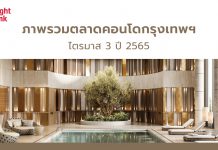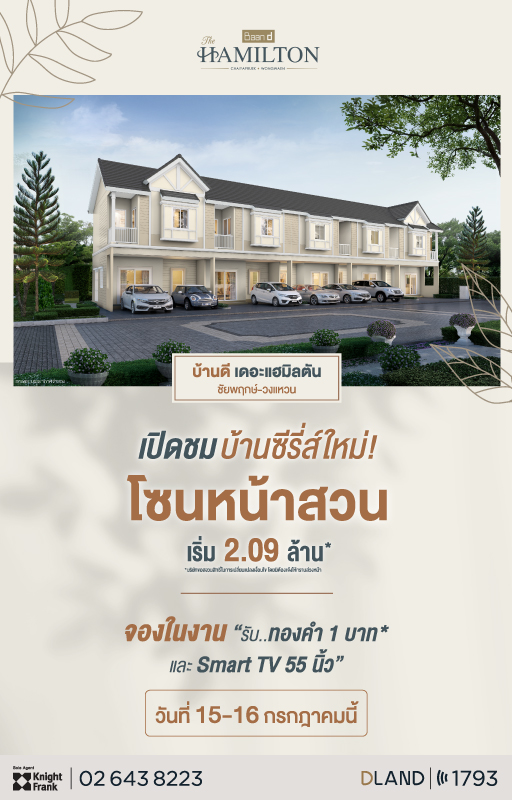Mr. Frank Khan, Executive Director and Head of Residential, Knight Frank Thailand Co., Ltd. said that the Bangkok condominium market in 2016 continued to grow at a slower pace than the year 2015 due to the Thai economic slowdown. The supply from the peripheral Bangkok areas dominated the market with total launches approximately 76% of the total supply in 2016. This is due to the development of the mass transit extension route to the suburban area of Bangkok; many developers thus launched projects along the new mass transit route in the suburban area due to the availability of land with reasonable prices.
However, the story of the MRT Purple Line (Tao Poon to Klong Bang Pai) will be a case study for both developers and condominium buyers, due to the fact that actual passenger numbers were nearly three times lower than the number of expected passengers as the line is not yet connected to other mass transit routes. This situation has affected the condominium market along the purple line where the line has been in operation last year but the unsold units are left in the market.
Overall, condominium demand was weak due to the sluggish demand in condominiums in the peripheral area of Bangkok, where many buyers were unable to secure mortgages. The condominium prices in the peripheral area of Bangkok will remain stable, whereas the condominium prices in the CBD and city fringe will increase slightly due to the limited new supply. The new condominium units in the city fringe will compete with old condominium units in well-maintained buildings located in the CBD since the price of newly built units in city fringe will be higher than the old condominium units located in the CBD.
Ms. Potjaman Vorakitpokathorn, Director – Project Marketing, Residential Department, Knight Frank Thailand add that the price of condominiums located in the suburban area of Bangkok is estimated to be stable. However, developers have to conduct a market survey before embarking on a condominium project in some particular areas in Bangkok’s suburbs. With the sharp increase of the selling price of condominiums in the CBD and city fringe, the resales market of condominiums in the CBD will compete with the new condominium projects due to the larger gap among selling prices. For those condominiums, end-users may look to the resales units in well-maintained buildings rather than buying from the new projects due to the cheaper price tag as well as the unit size, which will be larger in the old buildings.
Supply Trend
According to Knight Frank Thailand’s research, the Bangkok condominium supply at the end of 2016 amounted to 435,805 units, of which around 52,195 units were launched in 2016, representing an increasing of roughly 13.6% from last year. The majority of the new supply was from listed developers in order to create a backlog for future revenue; the high amount of supply doesn’t reflect the recovery of condominium demand. The majority of new launches were still in the peripheral Bangkok area, representing 76% of 2016’s new supply, followed by the city fringe area at 14%. Also, the data has shown that there appears to be 10% new supply in the CBD in 2016, as shown in Figure 2. Mostly in the second half of 2016, nine new projects were launched in the CBD, while 12 and 50 projects were launched in the city fringe and peripheral areas, respectively. The majority of the new launches in the peripheral area of Bangkok in the second half of 2016 was along the MRT Dark Blue Line Extension 2 (Hua Lamphong – Thapra – Laksong) and 3 (Laksong – Phuttamonthon Sai 4), followed by the BTS Extension Line South Extension (Bearing – Samrong – Samutprakarn), with construction progressing over 80%.
Figure 1: Supply & New Supply of Bangkok Condominium, 2008-2016

Source: Knight Frank Thailand
Figure 2: New supply by location 2016

Demand Trend
There were approximately 315,393 condominium units being sold out of 435,805 units, representing a sold rate of 72.4%, a decrease from the previous year, which was 75.3%. The condominium units being sold in 2016 included only 26,595 units, decreasing by 59% compared to the year 2015, with approximately 64,170 units sold in 2015. This could be due to the weakening purchasing power of buyers and more stringent loan standards by banks. As such, developers were also launching special promotional campaigns to boost their sales; the campaigns included discounted purchase prices, special interest rate offers and more.
FIGURE 3: Supply, Demand and Take-Up Rate of 2008-2016

Source: Knight Frank Thailand
Price Trend
The prices of newly launched condominium projects continued to climb throughout Bangkok but at different paces, depending on the location. The average selling price of condominium in the CBD was THB 229,180 per square metre, increasing by 5.3%. This was followed by the average selling price of city fringe condominiums, increasing by 4.8% to THB 134,842 per square metre and the average selling price of condominium in the peripheral area of Bangkok increasing by 3.6% to THB 76,002 per square metre.
Figure 4: Bangkok Condominium Average Selling Price, 2008-Q1 2016

Source: Knight Frank Thailand














